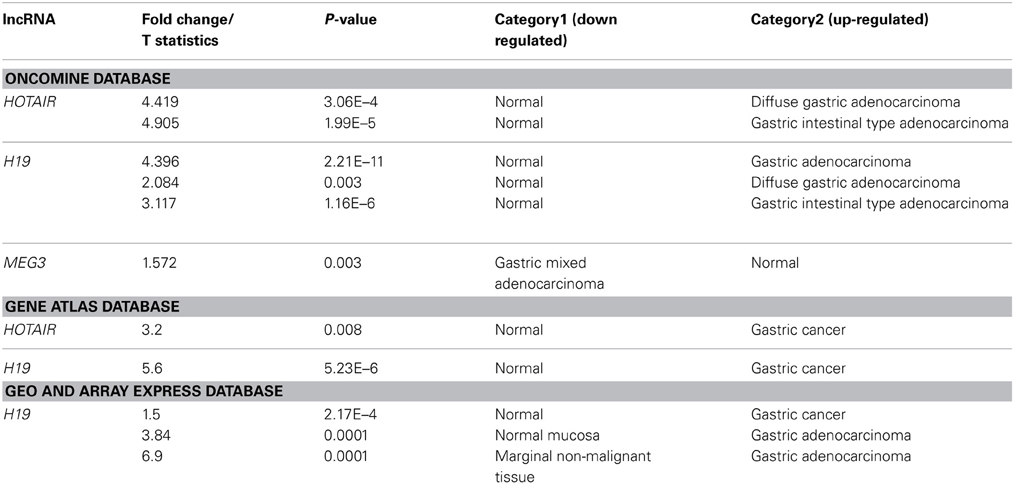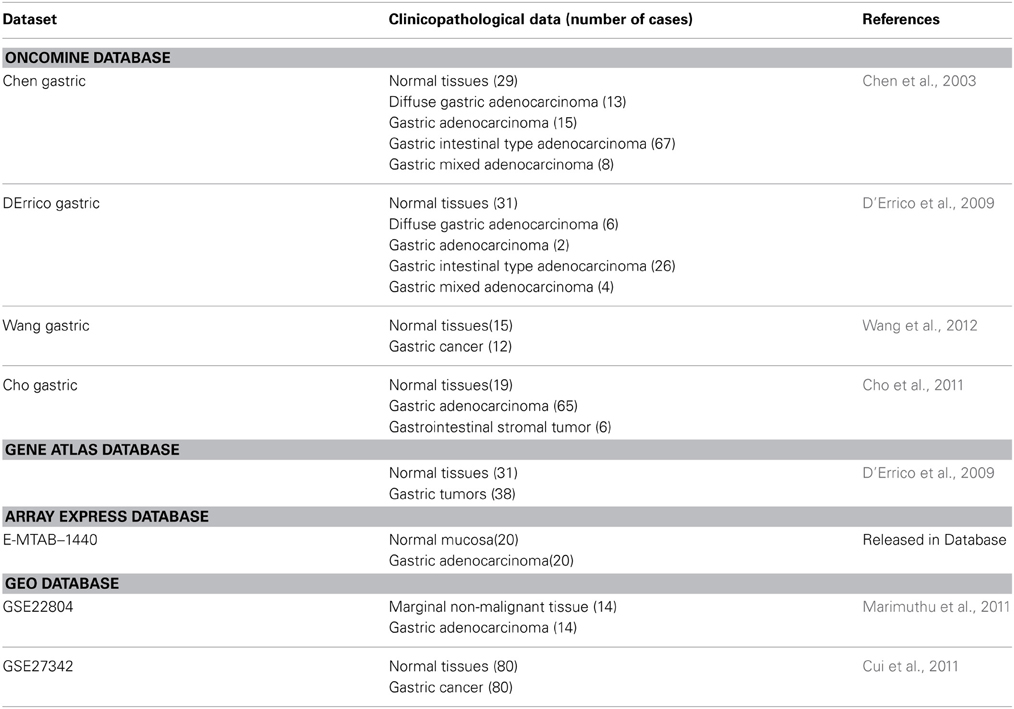- 1Department of Genetics, Shahid Chamran University of Ahvaz, Ahvaz, Iran
- 2Department of Genetics, School of Biological Sciences, Tarbiat Modares University, Tehran, Iran
Long non-coding RNAs are attracting the attention of researchers in many fields. These RNAs are longer than 200 nucleotides and do not encode any protein. A subset of them is reported to be strongly correlated with poor patient prognosis, suggesting a potential role in cancer progression (Esteller, 2011).
Gastric cancer is one of the most common malignant tumors worldwide. Therefore, there is an urgent need to find genes which are helpful in the diagnosis, prognosis, and understanding of the molecular pathways of this cancer (Hajjari et al., 2013a).
Finding novel molecular biomarkers of malignancy has been always important for clinical management. Like proteins, mRNAs, and miRNAs, lncRNAs show potentials as novel biomarkers and therapeutic targets in different cancer types (Zhang et al., 2013). However, there are a few reports on studying the relationship between gastric cancer progression and lncRNAs. Some useful clues for further researches seem necessary for deciphering the potential role of lncRNAs in gastric cancer. In this report, we present and highlight some evidences about the potential role of lncRNAs in gastric cancer based on the data indicated in Microarray databases. The results may give novel perspectives for further researches on the role of lncRNAs in gastric carcinogenesis.
We used different databases including Oncomine, Gene Expression Atlas, Gene Expression Omnibus (GEO), and Array Express Databases to analyze the expression level of most recent cited and noted lncRNAs in studies on cancer progression (Niland et al., 2012; Zhang et al., 2013). The selected lncRNAs have been regarded as the most potential biomarkers in the studies on different cancer types (Zhang et al., 2013). The RNAs include H19, MALAT-1, HOTAIR, ANRIL, CRNDE, and MEG3. Some descriptions of these lncRNAs are presented below.
Oncomine cancer microarray database was used to mine the lncRNA expression profile data according to the established methodology (Rhodes et al., 2007). Four publicly available datasets [Chen Gastric (Chen et al., 2003), DErrico Gastric (D'Errico et al., 2009), Wang Gastric (Wang et al., 2012), and Cho Gastric (Cho et al., 2011)] were inquired for our analysis. By using Oncomine and other microarray expression data accessible from GEO, Gene expression Atlas, and Array Express database, we found some significant differences of expression level for the lncRNAs. The datasets and clinopathological data of each study are presented in Table 1.
Student's t-test was used for the differential expression analyses. Those which have significant differences (Fold change > 1.5, P-value < 0.01) between gastric cancer and normal tissues are brought in Table 2.

Table 2. Significant difference (Fold change > 1.5, P-value < 0.01) of the expression level of lncRNAs between gastric cancer types and normal tissues.
MALAT-1
We found that the expression level of MALAT-1 is not significantly different between gastric cancer and normal tissues in the datasets. MALAT-1 was originally identified to be up-regulated in patients at the high risk of metastasis of non-small cell lung tumors (NSCLC). It seems that MALAT-1 functions in the regulation of alternate splicing by modulating the activity of SR proteins (Ji et al., 2003).
ANRIL
There are some reports indicating that ANRIL plays an important role in the repression of P14ARF, P15INK4b, and P16INK4a. The proposed mechanism of ANRIL is an interaction with Polycomb complexes and silencing target genes. Although some relationships between the ANRIL gene and cancer progression have been reported (Yu et al., 2008), we could not find any significant differences of expression between gastric tumor and normal tissues in the datasets.
CRNDE
CRNDE has been identified as an lncRNA whose expression is highly elevated in some tumors. It seems that CRNDE is associated with a “stemness” signature in some cancer types (Ellis et al., 2012). For the expression of this lncRNA, we did not find any significant differences between gastric cancer and normal tissues in selected datasets.
HOTAIR
The datasets show that this lncRNA is up-regulated in gastric adenocarcinoma compared with normal tissues. HOTAIR is an lncRNA that binds to the PRC2 complex and targets it at some genes involved in tumor suppression. Its up-regulation is reported in different cancer types (Gupta et al., 2010).
H19
There is a significant up-regulation in gastric adenocarcinoma tissues compared with normal ones in our results drawn from databases (Table 2). H19 is an lncRNA which is implicated as having both oncogenic and tumor suppression properties. These two controversial roles of H19 may be attributed to the nature of H19 function or context in different tissues. Our results may support its oncogenic role in gastric carcinogenesis.
MEG3
MEG3 is an lncRNA which is identified as having an inhibitory role in tumor growth. This lncRNA is the first one proposed to have a tumor suppressor role (Zhang et al., 2003). By querying the databases, we found that the expression level of MEG3 is down-regulated in gastric adenocarcinoma compared with normal tissues.
Altogether, based on the results, it seems that some lncRNAs such as HOTAIR, H19, and MEG3 may potentially be suitable candidates for study in order to find some biomarkers or therapeutic targets. Hajjari et al. found a significant up-regulation of HOTAIR lncRNA in gastric adenocarcinoma tissues compared with normal ones by Real-time PCR (Hajjari et al., 2013b). Also, Yang et al. found that H19 levels were increased in gastric cancer cells and tissues compared with normal controls (Yang et al., 2012). These studies provide supportive evidences concerning the important role of these two lncRNAs in gastric cancer progression.
The different expression of certain cancer type-specific lncRNAs can be exploited for the development of novel biomarkers as lncRNA expression (Gibb et al., 2011). Although there are some reports indicating the effect of down-regulation of HOTAIR and H19 on cell proliferation and metastasis (Yang et al., 2012; Xu et al., 2013), we believe that these functional studies are worth being undertaken on more samples. Besides, understanding their biological roles in normal developments might provide some directions for using these enigmatic molecules as diagnostic or predictive biomarkers.
Our results, drawn from microarray databases, may help researchers to investigate the role of lncRNAs in gastric cancer progression. Large scale and follow-up studies are necessary to consider lncRNAs such as HOTAIR and H19 as potential biomarkers or therapeutic targets in this type of cancer.
References
Chen, X., Leung, S. Y., Yuen, S. T., Chu, K. M., Ji, J., Li, R., et al. (2003). Variation in gene expression patterns in human gastric cancers. Mol. Biol. Cell 14, 3208–3215. doi: 10.1091/mbc.E02-12-0833
Cho, J. Y., Lim, J. Y., Cheong, J. H., Park, Y. Y., Yoon, S. L., Kim, S. M., et al. (2011). Gene expression signature-based prognostic risk score in gastric cancer. Clin. Cancer Res. 17, 1850–1857. doi: 10.1158/1078-0432.CCR-10-2180
Cui, J., Chen, Y., Chou, W. C., Sun, L., Chen, L., Suo, J., et al. (2011). An integrated transcriptomic and computational analysis for biomarker identification in gastric cancer. Nucleic Acids Res. 39, 1197–1207. doi: 10.1093/nar/gkq960
D'Errico, M., De Rinaldis, E., Blasi, M. F., Viti, V., Falchetti, M., Calcagnile, A., et al. (2009). Genome-wide expression profile of sporadic gastric cancers with microsatellite instability. Eur. J. Cancer 45, 461–469. doi: 10.1016/j.ejca.2008.10.032
Ellis, B. C., Molloy, P. L., and Graham, L. D. (2012). CRNDE: a long non-coding RNA involved in cancer, neurobiology, and development. Front. Genet. 3:270. doi: 10.3389/fgene.2012.00270
Esteller, M. (2011). Non-coding RNAs in human disease. Nat. Rev. Genet. 12, 861–874. doi: 10.1038/nrg3074
Gibb, E. A., Brown, C. J., and Lam, W. L. (2011). The functional role of long non-coding RNA in human carcinomas. Mol. Cancer 10, 38. doi: 10.1186/1476-4598-10-38
Gupta, R. A., Shah, N., Wang, K. C., Kim, J., Horlings, H. M., Wong, D. J., et al. (2010). Long non-coding RNA HOTAIR reprograms chromatin state to promote cancer metastasis. Nature 464, 1071–1076. doi: 10.1038/nature08975
Hajjari, M., Behmanesh, M., Sadeghizadeh, M., and Zeinoddini, M. (2013a). Junctional adhesion molecules 2 and 3 may potentially be involved in progression of gastric adenocarcinoma tumors. Med. Oncol. 30, 380. doi: 10.1007/s12032-012-0380-z
Hajjari, M., Behmanesh, M., Sadeghizadeh, M., and Zeinoddini, M. (2013b). Up-regulation of HOTAIR long non-coding RNA in human gastric adenocarcinoma tissues. Med. Oncol. 30, 670. doi: 10.1007/s12032-013-0670-0
Ji, P., Diederichs, S., Wang, W., Böing, S., Metzger, R., Schneider, P. M., et al. (2003). MALAT-1, a novel noncoding RNA, and thymosin beta4 predict metastasis and survival in early-stage non-small cell lung cancer. Oncogene 22, 8031–8041. doi: 10.1038/sj.onc.1206928
Marimuthu, A., Jacob, H. K. C., Jakharia, A., Subbannayya, Y., Keerthikumar, S., Kashyap, M. K., et al. (2011). Gene expression profiling of gastric cancer. J. Proteom. Bioinform. 4, 74–82. doi: 10.4172/jpb.1000170
Niland, C. N., Merry, C. R., and Khalil, A. M. (2012). Emerging roles for long non-coding RNAs in cancer and neurological disorders. Front. Genet. 3:25. doi: 10.3389/fgene.2012.00025
Rhodes, D. R., Kalyana-Sundaram, S., Mahavisno, V., Varambally, R., Yu, J., Briggs, B. B., et al. (2007). Oncomine 3.0: genes, pathways, and networks in a collection of 18,000 cancer gene expression profiles. Neoplasia 9, 166–180. doi: 10.1593/neo.07112
Wang, Q., Wen, Y. G., Li, D. P., Xia, J., Zhou, C. Z., Yan, D. W., et al. (2012). Upregulated INHBA expression is associated with poor survival in gastric cancer. Med. Oncol. 29, 77–83. doi: 10.1007/s12032-010-9766-y
Xu, Z. Y., Yu, Q. M., Du, Y. A., Yang, L. T., Dong, R. Z., Huang, L., et al. (2013). Knockdown of long non-coding RNA HOTAIR suppresses tumor invasion and reverses epithelial-mesenchymal transition in gastric cancer. Int. J. Biol. Sci. 9, 587–597. doi: 10.7150/ijbs.6339
Yang, F., Bi, J., Xue, X., Zheng, L., Zhi, K., Hua, J., et al. (2012). Up-regulated long non-coding RNA H19 contributes to proliferation of gastric cancer cells. FEBS J. 279, 3159–3165. doi: 10.1111/j.1742-4658.2012.08694.x
Yu, W., Gius, D., Onyango, P., Muldoon-Jacobs, K., Karp, J., Feinberg, A. P., et al. (2008). Epigenetic silencing of tumour suppressor gene p15 by its antisense RNA. Nature 451, 202–206. doi: 10.1038/nature06468
Zhang, H., Chen, Z., Wang, X., Huang, Z., He, Z., and Chen, Y. (2013). Long non-coding RNA: a new player in cancer. J Hematol. Oncol. 6, 37. doi: 10.1186/1756-8722-6-37
Keywords: long non-coding RNAs, expression level, gastric cancer, oncomine, biomarker
Citation: Hajjari M and Khoshnevisan A (2013) Potential long non-coding RNAs to be considered as biomarkers or therapeutic targets in gastric cancer. Front. Genet. 4:210. doi: 10.3389/fgene.2013.00210
Received: 12 September 2013; Accepted: 01 October 2013;
Published online: 18 October 2013.
Edited by:
Muller Fabbri, Childrens' Hospital Los Angeles and Keck School of Medicine University od Southern California, USAReviewed by:
Daisuke Ichikawa, Kyoto Prefectural University of Medicine, JapanCopyright © 2013 Hajjari and Khoshnevisan. This is an open-access article distributed under the terms of the Creative Commons Attribution License (CC BY). The use, distribution or reproduction in other forums is permitted, provided the original author(s) or licensor are credited and that the original publication in this journal is cited, in accordance with accepted academic practice. No use, distribution or reproduction is permitted which does not comply with these terms.
*Correspondence:bW9oYW1hZC5oYWphcmlAZ21haWwuY29t
 Mohammadreza Hajjari
Mohammadreza Hajjari Atefeh Khoshnevisan
Atefeh Khoshnevisan